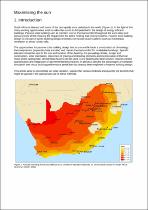JavaScript is disabled for your browser. Some features of this site may not work without it.
- ResearchSpace
- →
- Research Publications/Outputs
- →
- Book Chapters
- →
- View Item
| dc.contributor.author |
Conradie, Dirk CU

|
|
| dc.date.accessioned | 2014-07-22T07:45:35Z | |
| dc.date.available | 2014-07-22T07:45:35Z | |
| dc.date.issued | 2010-08 | |
| dc.identifier.citation | Conradie, D.C.U. 2010. Maximising the sun. In: Green Building Handbook South Africa: The Essential Guide, Volume 3, pp 146-159 | en_US |
| dc.identifier.uri | http://hdl.handle.net/10204/7519 | |
| dc.description | Green Building Handbook South Africa: The Essential Guide, Volume 3 | en_US |
| dc.description.abstract | South Africa is blessed with some of the best quality solar radiation in the world. In the light of this many exciting opportunities exist to utilize the sun to its full potential in the design of energy efficient buildings. Passive solar buildings aim to maintain interior thermal comfort throughout the sun's daily and annual cycles whilst reducing the requirement for active heating and cooling systems. Passive solar building design is one part of green building design and does not include active systems such as mechanical ventilation or photo voltaic cells. The opportunities for passive solar building design has as a scientific basis a combination of climatology, thermodynamics (especially heat transfer) and human thermal comfort for inhabitable buildings. Specific attention should be paid to the site and location of the dwelling, the prevailing climate, design and construction, solar orientation, placement of glazing and shading elements and incorporation of thermal mass where appropriate. Whilst these factors can be used in any building the ideal solution requires careful quantification and integration of abovementioned principles. In previous articles the advantages of computer simulation and virtual building performance prediction has already been explored to improve building design. This chapter aims to concentrate on solar radiation, explore the various methods and quantify the benefits that might be gained in the appropriate use of these methods. | en_US |
| dc.language.iso | en | en_US |
| dc.publisher | Green Building | en_US |
| dc.relation.ispartofseries | Workflow;4673 | |
| dc.subject | Green buildings | en_US |
| dc.subject | Solar | en_US |
| dc.subject | Solar radiation | en_US |
| dc.subject | Solar building | en_US |
| dc.title | Maximising the sun | en_US |
| dc.type | Book Chapter | en_US |
| dc.identifier.apacitation | Conradie, D. C. (2010). Maximising the sun., <i>Workflow;4673</i> Green Building. http://hdl.handle.net/10204/7519 | en_ZA |
| dc.identifier.chicagocitation | Conradie, Dirk CU. "Maximising the sun" In <i>WORKFLOW;4673</i>, n.p.: Green Building. 2010. http://hdl.handle.net/10204/7519. | en_ZA |
| dc.identifier.vancouvercitation | Conradie DC. Maximising the sun.. Workflow;4673. [place unknown]: Green Building; 2010. [cited yyyy month dd]. http://hdl.handle.net/10204/7519. | en_ZA |
| dc.identifier.ris | TY - Book Chapter AU - Conradie, Dirk CU AB - South Africa is blessed with some of the best quality solar radiation in the world. In the light of this many exciting opportunities exist to utilize the sun to its full potential in the design of energy efficient buildings. Passive solar buildings aim to maintain interior thermal comfort throughout the sun's daily and annual cycles whilst reducing the requirement for active heating and cooling systems. Passive solar building design is one part of green building design and does not include active systems such as mechanical ventilation or photo voltaic cells. The opportunities for passive solar building design has as a scientific basis a combination of climatology, thermodynamics (especially heat transfer) and human thermal comfort for inhabitable buildings. Specific attention should be paid to the site and location of the dwelling, the prevailing climate, design and construction, solar orientation, placement of glazing and shading elements and incorporation of thermal mass where appropriate. Whilst these factors can be used in any building the ideal solution requires careful quantification and integration of abovementioned principles. In previous articles the advantages of computer simulation and virtual building performance prediction has already been explored to improve building design. This chapter aims to concentrate on solar radiation, explore the various methods and quantify the benefits that might be gained in the appropriate use of these methods. DA - 2010-08 DB - ResearchSpace DP - CSIR KW - Green buildings KW - Solar KW - Solar radiation KW - Solar building LK - https://researchspace.csir.co.za PY - 2010 T1 - Maximising the sun TI - Maximising the sun UR - http://hdl.handle.net/10204/7519 ER - | en_ZA |






